
In today's article, we'll put our best foot forward as we chart the rise of flip flops and modern menswear, and we'll also determine how and why men started wearing them. In some quarters, flip flops are maligned as everything that is wrong with modern menswear—comfort-obsessed, overly casual, and disposable. But since 2006, flip-flop sales have eclipsed even sneaker sales in North America. So whether you consider them tops or flops, flip flops have certainly flipped the script when it comes to casual footwear.
Now, in this piece, we'll learn about the history of flip flops and their precursor, the sandal. We'll follow their progress into the 20th century and the explosion of popularity that flip-flops have experienced since the early 2000s. We'll determine why men started wearing flip flops and their place within classic style—because believe it or not, they do have a place. First, we need to trace the origins and development of the flip-flop through history.
Our story begins in ancient Greece when, just kidding, in actuality, sandals—the proto flip flops—are one of the oldest shoe types. A cache of woven fiber sandals found in Oregon's Fort Rock Cave could be around 10,000 years old. Now these would be great at the Hamptons—do they come in a size 10? And some truly fantastic sandals could be found in ancient Egypt. Most ancient Egyptians went barefoot, and only wealthy and important figures wore sandals. Accordingly, some were highly decorated, like this example, which comes from the tomb of the famous pharaoh King Tut.
When comparing construction, you'll see that the toe post design hasn't changed much between this example, which is about 3,000 years old, and modern flip flops. Of course, sandal design varied greatly depending on location and function. The statutory fragment from the 1st or 2nd century AD offers a glimpse of a Roman military sandal, and in this illustration, we see a Japanese samurai donning a pair of geta waraji.
Sandals were worn in the West well into the early modern period, often as an inexpensive day shoe for utilitarian functions or for travel. They are even mentioned in Shakespeare: "How should I your true love know from another? / By his cockle hat and staff, and his sandal shoon." Now, Raphael will teach you more about sandals and why they aren't in favor for classic style in this video, but for our purposes today, let's skip ahead to the middle of the 20th century.

Flip Flops History: Tracing the Origins of Casual Footwear
The flip-flop's history is a fascinating journey that underscores its timeless appeal as a staple in casual footwear. According to popular tradition, Allied servicemen stationed in Japan after World War II adapted the tradition of wearing zoris—house shoes. Zoris are a type of slip-on Japanese sandal that evolved from the aforementioned waraji. Wartime constraints near the end of World War II necessitated that Japanese zoris be made out of rubber, and upon the war's conclusion, these rubber zoris could be made cheaply and sold across the globe.
They soon became associated with comfort and ease and were solely adopted by the burgeoning surf culture in North America, Australia, and New Zealand. In most Anglophonic nations, these shoes were widely referred to as thongs—okay, okay, guys, get the giggles out now because thong is a term for a leather strap, the strap used on these shoes. Although the name jandals was also sometimes used as a portmanteau of Japanese sandals, the term flip flops is an onomatopoeia of the sound they make when they are worn, and it became commonplace in the late 1960s in North America.
In 1962, the Brazilian company Havaianas started mass-producing these rubber sandals that resemble zoris with distinctive blue and white coloring. Their name comes from the Portuguese word for Hawaiians because a similar style of sandals is often a common sight on the beaches of Hawaii, which has a large population of Japanese immigrants. In Brazil, Havaianas were associated with the working classes, and within a few years, they were one of the nation's most popular shoe styles. In 1966, the owners of Havaianas patented their design, and for all intents and purposes, the modern flip-flop was fully born.
For most of the 1950s and early 1960s, a more traditional style of shoe had remained popular with beachgoers, such as boat shoes, the Canvas Keds, and this advertisement from 1962, and espadrilles like those worn by Alain Delon in Plein Soleil, an early film adaptation of The Talented Mr. Ripley. And you can see a review of the style in the 1999 film here. But as the 1960s wore on, flip flops became synonymous with beach life, beloved by surfers, appearing poolside, and even earning a mention in the 1964 Beach Boys song All Summer Long.
The popularity of flip flops and similar casual shoes continued to grow. In the early 1970s, entrepreneur J. Longley began hand-making flip flops out of rubber and leather out of his Laguna Beach, California home, averaging about 15 pairs a day. In 1974, he founded Rainbow Sandals in San Clemente, California, and could turn out about 1,200 a day from its production facility—and that same facility is still up and running today.
Around the same time, University of California, Santa Barbara students Doug Otto and Carl something were selling their own flip flops, which they dubbed Deckers because the layered construction of the soles resembled wooden decks. In 1984, Reef Sandals was founded by Argentine brothers Fernando and Santiago Aguerre after they moved to La Jolla, California. Reef products were originally manufactured in Brazil, like Havaianas, and this connection was emphasized in Reef advertising—so talking about thongs is also going to get us demonetized.
In 1984, Teva sandals were conceived when Mark Thatcher, a Grand Canyon river guide, was distressed over how often his flip-flops would float away. He then used Velcro straps to affix them to his feet. In the 1990s, flip flops and other sport sandals grew in popularity both at the beach and for other outdoor excursions like walking or hiking. They must have given out those Teva sandals at hospital nurseries because everyone's dad seemed to have a pair.
This deep dive into the flip-flop's history reveals how these simple sandals evolved from wartime necessities to cultural icons. The transition from ancient prototypes to mid-20th-century innovations laid the groundwork for their global dominance. As we explore further, it's clear that the design's simplicity—breathable, affordable, and functional—has been the key to its longevity. Whether you're researching flip-flop history for style inspiration or curiosity, understanding these roots helps appreciate their role in today's wardrobes.
After saturating the leisure market, flip-flop manufacturers undertook a considered effort in the early 2000s to market their wares as perfectly acceptable everyday shoes. Children and young people were some of the first to accept this trend. The evolution from beach accessory to daily essential is a testament to clever branding and shifting societal norms, making flip flops a high-volume search term in the world of casual footwear.
Why Men Started Wearing Flip Flops: Leisure, Casualization, and Comfort
Delving into why men started wearing flip flops uncovers layers of cultural, social, and practical shifts that transformed them from seasonal oddities to wardrobe staples. While men started wearing flip flops following the Second World War, additional leisure time and reduced blue-collar demands made it easier than ever to take vacations and holiday time, especially to distant exotic locations with beaches as a favored getaway location.
As modern holiday culture was still developing, there was not yet an established wardrobe, so vacationers quickly learned to pick up local items that would suit the climate. We love leather dress shoes, but even we have to admit they don't mix well with beaches. Flip flops, being cheap, easy to fit, and ideal for hot climates, were a favorite purchase, and because they're easy to pack, these flip flops were often taken home both for occasional use but also as a souvenir of the trip. Oftentimes, these beach accessories could find themselves adopted into regular clothing rotation, especially when the wearers find themselves missing the seaside and the beach lifestyle.
That laid-back surf lifestyle first explored by beach culture soon became its own ethos in the popular psyche—between Salt Life decals, Margaritaville restaurants, and the beach country musical subgenre, it was clear that people wanted to relax and enjoy a more laid-back beach lifestyle even when not at the beach. And one way to do that was to regularly wear flip flops.
This trend crashed headlong into the great casualization of menswear, and the result was an increasing willingness to accept flip flops outside of pools and beachfronts. As society became increasingly casual, workplaces followed, albeit much more slowly. Many of the new industries of the 90s and 2000s, primarily in the computer and digital arenas, were more willing to adapt to the desires of the workers to dress more casually in the workplace, forsaking suits and oxfords for t-shirts and flip flops.
Like flip flops, these tech industries were nurtured under the sunny skies of California, and that beach life attitude found its way to Silicon Valley boardrooms, helped along by a more utilitarian capitalism. They didn't quite care how workers were dressed, just as long as they clocked in every day and did their work. Flip flops were soon accepted as workplace-appropriate in many areas.
The uniting factor in the overall popularity of flip flops and the casualization of menswear in general is that flip flops are more comfortable than conventional shoes. Most modern flip-flop makers have geared their marketing to stress this point, with construction or design to make their products suitable for all-day wear. Now, from personal experience, we haven't quite found flip flops to be comfortable for all-day wear, especially when compared to a well-made pair of dress shoes, and for many people, the lack of support can lead to physical issues. That hasn't done much to shake the popular perception that the lightweight design and exposed ventilation of flip flops, which allegedly mimics the experience of being barefoot, make them that much more comfortable.
Finally, we'll offer one more explanation as to why men started wearing flip flops that goes all the way back to the shoe's origins. When flip flops were first introduced, a beach body craze had young men desperately trying to achieve the muscled and chiseled physique of Charles Atlas. And from the 20s onwards, as the flip-flop rose to primacy, the desire to emulate ripped reality TV stars, muscle-bound musicians, and the latest heartthrob superheroes has only grown stronger. With more and more men invested in health-conscious living and regular sessions at the gym, flip flops may be an extension of the desire to wear at leisure because they highlight your build, showing off the hard work you put into building the perfect body. Like shorts or sleeveless shirts, the flip-flop puts more of the body on display, perhaps explaining their popularity with young athletic celebrities.
Perhaps in this sense, flip flops are reminiscent of the ancient sandals worn by the gods and heroes immortalized in marble. The social movements were helped by the fact that, as mentioned, these manufacturers marketed these flip flops as everyday wear. So between organic desire and a little prepackaged push, it's not hard to see how flip-flops got such a strong foothold in menswear.
Exploring why men started wearing flip flops reveals a blend of practicality and aspiration. The post-war leisure boom made beaches accessible, turning flip flops into must-have souvenirs that lingered in closets. As work cultures relaxed—especially in California's tech hubs—these shoes symbolized a rejection of stiff formality in favor of an effortless vibe. Comfort claims, though debatable, fueled marketing, while gym culture added a show-off element, echoing ancient ideals of heroic physiques. This multifaceted rise ties directly into broader searches like shoes for men, where flip flops stand out for their versatility in casual settings.
In essence, flip flops didn't just happen; they were propelled by vacations, corporate chill, and a cultural craving for ease. For men navigating modern wardrobes, understanding these drivers explains their ubiquity beyond the shore.
The Explosion of Flip Flop Popularity Since the 2000s: From Scandal to Staple
The explosion of flip-flop popularity since the early 2000s marks a pivotal chapter in their story, turning them from niche beachwear to a global phenomenon. In 2005, the crew athletes from Northwestern University caused a minor sandal scandal in the United States when some players decided to wear flip flops to a formal photograph with President George W. Bush. Which is a few years later, In 2008, Barack Obama became the first sitting US president to appear in public wearing flip-flops at an ice cream parlor in Hawaii.
By this time, flip flops had already become a common sight across the globe for about a decade, worn by everyday men as they ran errands or day chores, but also gracing the feet of the famous, including JC Chasez and Justin Timberlake of NSYNC, Leonardo DiCaprio, and Liam Hemsworth. And despite Raphael's very best efforts, flip flops are now considered a mainstay in many menswear spheres.
Several luxury brands have even entered the flip-flop market, including Gucci retailing at $320, Louboutin at $350, and Giorgio Armani at $500. That's a long way for flip flops to go from the favelas of Brazil to the high fashion runway. But those aren't the only costs of flip flops. Due to their casual informal nature, many flip flops are treated as disposable products. Every year, about 3 billion flip-flops are made, and many promptly end up in the trash, constituting in some regions up to 25 percent of plastic pollutants in the ocean.
Recognizing the sad reality, several sustainable flip-flop companies have been founded, including the Hawaiian-based brand OluKai. In 2006, we traced the full history of the flip-flop from beach-going bobby to high fashion footwear, reflecting their seasonal surge and year-round appeal in warm climates. This explosion wasn't accidental; it was fueled by celebrity endorsements—from college athletes flouting protocol to presidents embracing chill—that normalized flip flops in unexpected places. Luxury adaptations elevated their status, while environmental concerns spurred innovation. As searches for sandals spike in summer, flip flops' story from scandal to staple highlights their adaptability, making them indispensable for modern men balancing comfort and conscience.
This phase of popularity underscores how flip-flops transcended origins, infiltrating errands, red carpets, and even boardrooms. The shift from disposable to desirable, via sustainable tweaks, ensures their staying power amid growing eco-awareness.
Flip Flops in Classic Menswear: Do They Have a Place?
Now the question becomes: should you wear flip flops as a part of an interest in classic style? We're still going to have to agree with the assessment Raphael made in our "19 Things Men Should Never Wear" video. When it comes to classic style, we do believe that flip flops have a place—that place just happens to be at the beach or at the pool.
If you're cultivating a classic look, we feel there aren't as many circumstances that will allow for flip-flops. And if flip flops just aren't your thing, don't fret—the classic style offers many alternatives that are beach-appropriate. You can find two of our favorites modeled by Sean Connery as James Bond in the 1965 film Thunderball. He wears a pair of simple leather sandals, which provide all of the airiness of flip flops but with a more secure fit and more classical lines, and also a pair of timeless espadrilles for a more formal, substantial look. But do you know my favorite thing about Thunderball? Awesome opening song by Tom Jones—"Thunderball."
Flip flops in classic menswear spark debate, yet their niche is clear: resort realms where breathability trumps formality. Flip flops fit as casual outliers, not core pieces. Alternatives like Bond's leather sandals or espadrilles bridge airiness and elegance, preserving timeless poise without the slap. For purists, this delineation keeps wardrobes sharp; for adventurers, it's permission to pack light.
We hope that in learning about the history of flip flops, you will better understand why men started wearing them and what their role is in relation to classic style. Personally, my favorite time to wear flip flops is when I'm on a boat. I got my swim trunks and my flip flops—I'm flipping now.
Today I'm wearing a brown veal skin jacket, a white and brown striped shirt, blue trousers, white leather sneakers, and brown Fort Belvedere socks. Check out the Fort Belvedere shop here for socks like these.
In the broader landscape of men's shoes for men, flip flops carve a relaxed corner, ideal for aquatic escapes or spontaneous dips. Their limited classic footprint encourages exploration of refined rivals, ensuring style stays elevated. This balance—acknowledging flip flops' charm while championing sophistication—defines the Gentleman's Gazette ethos.

Best Flip Flops for Men: Top Brands and Styles for 2025
Building on the flip flops' history and cultural ascent, selecting the best flip flops for men requires balancing heritage, comfort, and versatility. From Havaianas' iconic rubber classics—affordable at under $30 with that signature blue-and-white pop—to Rainbow Sandals' handcrafted leather pairs ($50+), which mold to your feet over time for supreme all-day ease, options abound for every vibe.
For adventure seekers, Teva's Velcro-secured models ($60) prevent float-aways on rivers or hikes, while Reef's Brazilian-made leather-rubber hybrids ($50) nod to surf roots with built-in bottle openers for beachside utility. Deckers' layered soles offer deck-like stability, perfect for casual strolls. Luxury seekers? Gucci's monogrammed versions ($320) or Louboutin's sleek designs ($350) infuse high fashion into flops.
Sustainability shines in OluKai's Hawaiian-inspired pairs ($130), using eco-materials to combat the 3 billion annual production waste. When hunting the best flip flops for men, prioritize arch support to sidestep issues—our picks emphasize ventilation and durability for beyond-beach wear. With summer 2025 trends leaning toward minimalist luxury, these standouts ensure you're flops-forward without faux pas.
Why Choose PCSsole?
PCSsole Flip Flops excel in addressing common pain points associated with traditional flip flops, such as lack of support, foot fatigue, and instability.
| Aspect | PCSsole Arch Support Flip-Flops | Other Brands |
|---|---|---|
| Arch Support | Up to 1.2 inches of orthopedic arch support, conforming precisely to the foot's curve for even weight distribution; reduces plantar pressure by 25% and fatigue by over 40%, aligned with APMA standards. | Often minimal or absent; may claim support but create pressure points or lack durability, leading to uneven load and increased risk of foot pain. |
| Material & Durability | Closed-cell foam with uniform density and high resilience; molds to foot shape after break-in; 3x more durable than regular foams, withstands daily wear without brittleness or deformation. | Typically basic EVA or rubber; prone to quick wear, cracking, or flattening, especially under prolonged use. |
| Strap Design | Firm yet flexible elastic band that securely locks the instep without toe gripping; endures 5,000+ bends without sagging; reduces calf fatigue by over 30% via natural windlass mechanism support. | Rigid or thin straps that cause slippage, rubbing, or toe pinching; require excessive toe effort, promoting poor gait and muscle strain. |
| Comfort & Fit | Customizable fit for wide/narrow feet; cloud-soft cushioning with no irritation; promotes relaxed toes and efficient push-off for all-day wear. | Generic sizing often leads to blisters, instability, or "seesaw" walking; limited adaptability to foot variations. |
| Health Benefits | Prevents 70%+ of summer foot issues (e.g., inflammation, fasciitis); supports body alignment from feet to spine/hips; ideal for prolonged standing/walking. | Basic cushioning at best; can exacerbate overpronation, heel pain, or arch collapse without targeted relief. |
| Versatility & Style | Waterproof, quick-drying, sweat-absorbing; available in 7 colors (e.g., Jet Black, Sky Blue); suits beach, office, gym, or hiking with a minimalist, shoe-like aesthetic. | Primarily casual/beach-focused; less adaptable to mixed activities, with fewer style options and poorer wet-weather performance. |
The PCSsole flip-flop differentiates itself by focusing on the science of the foot rather than just fashion or soft cushioning.


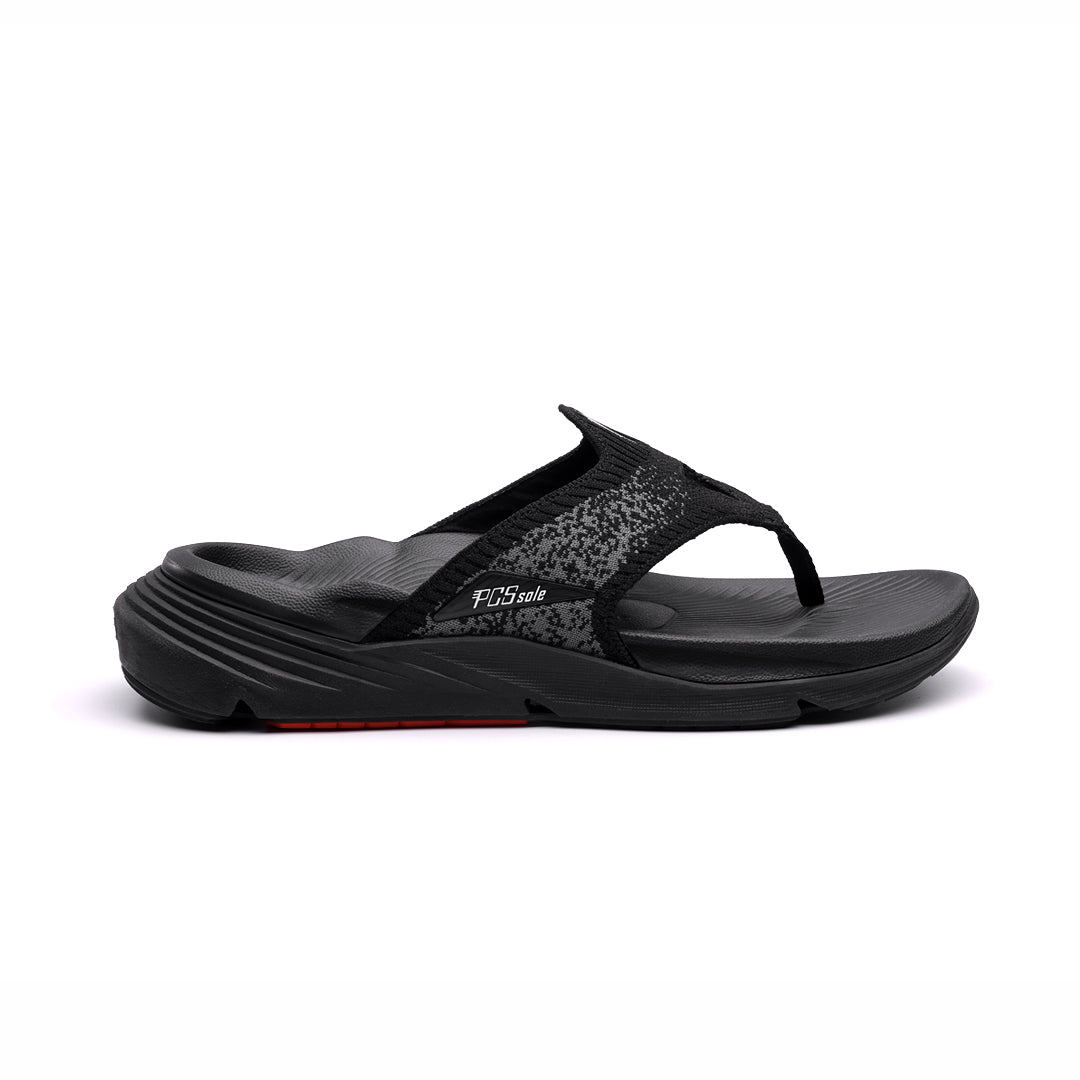
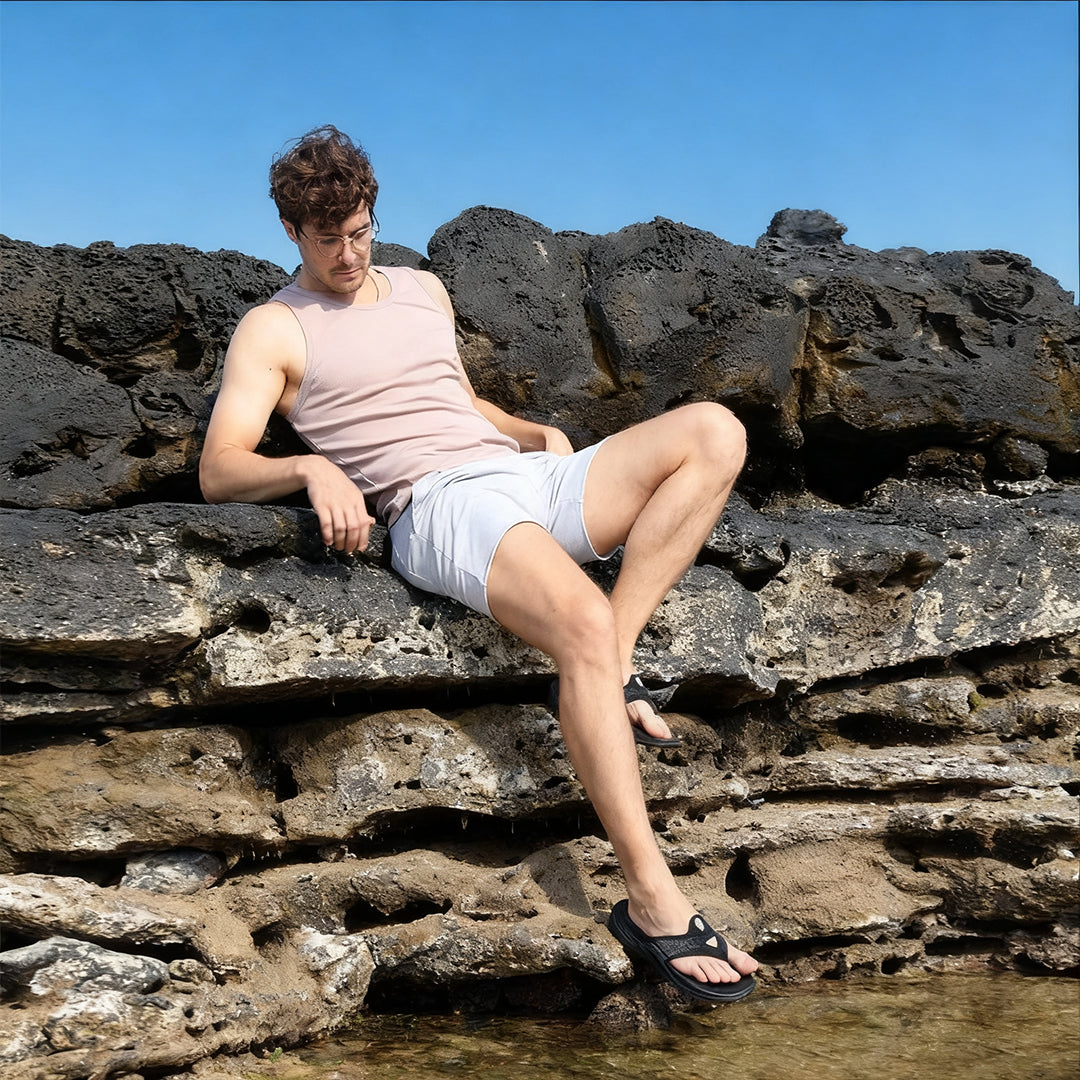
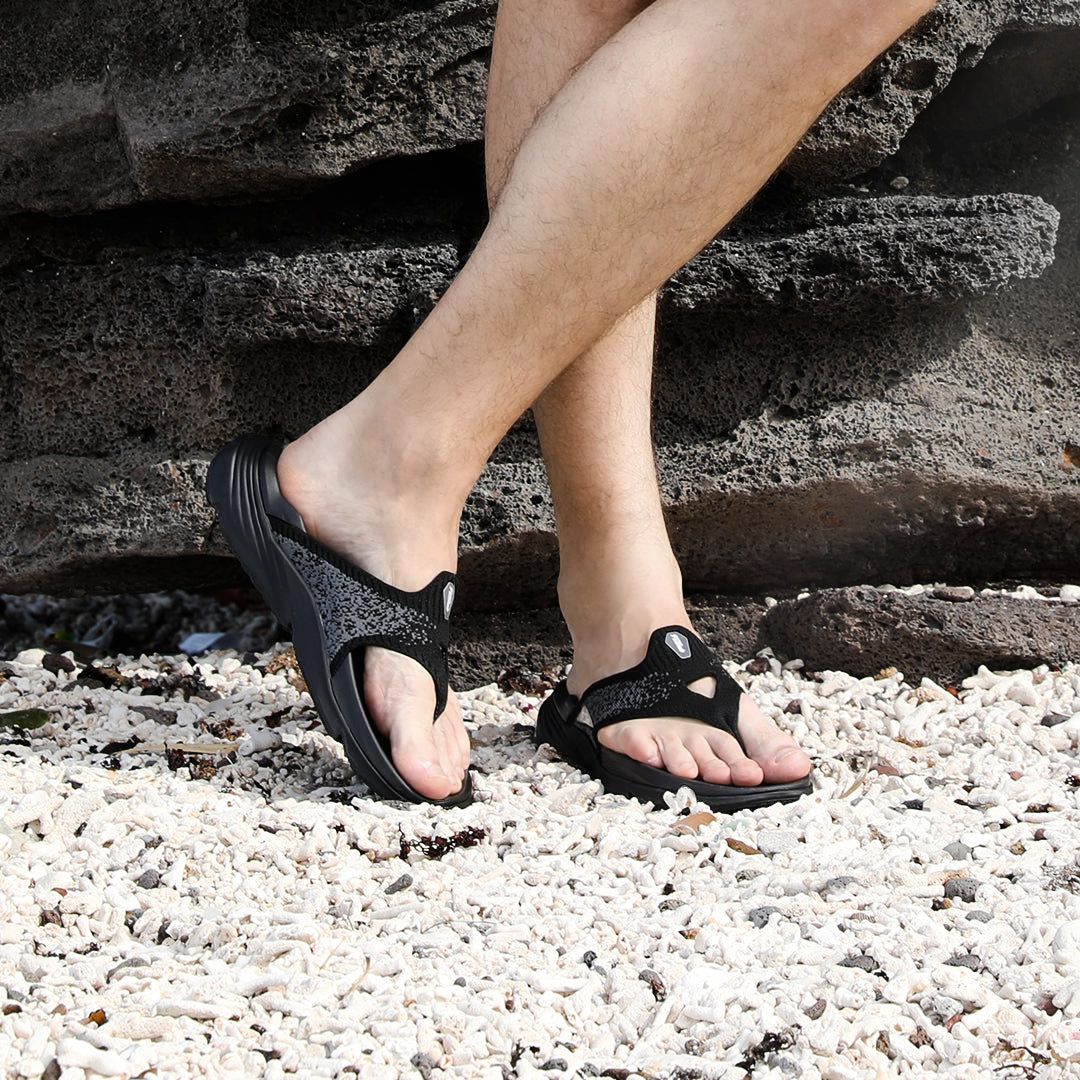
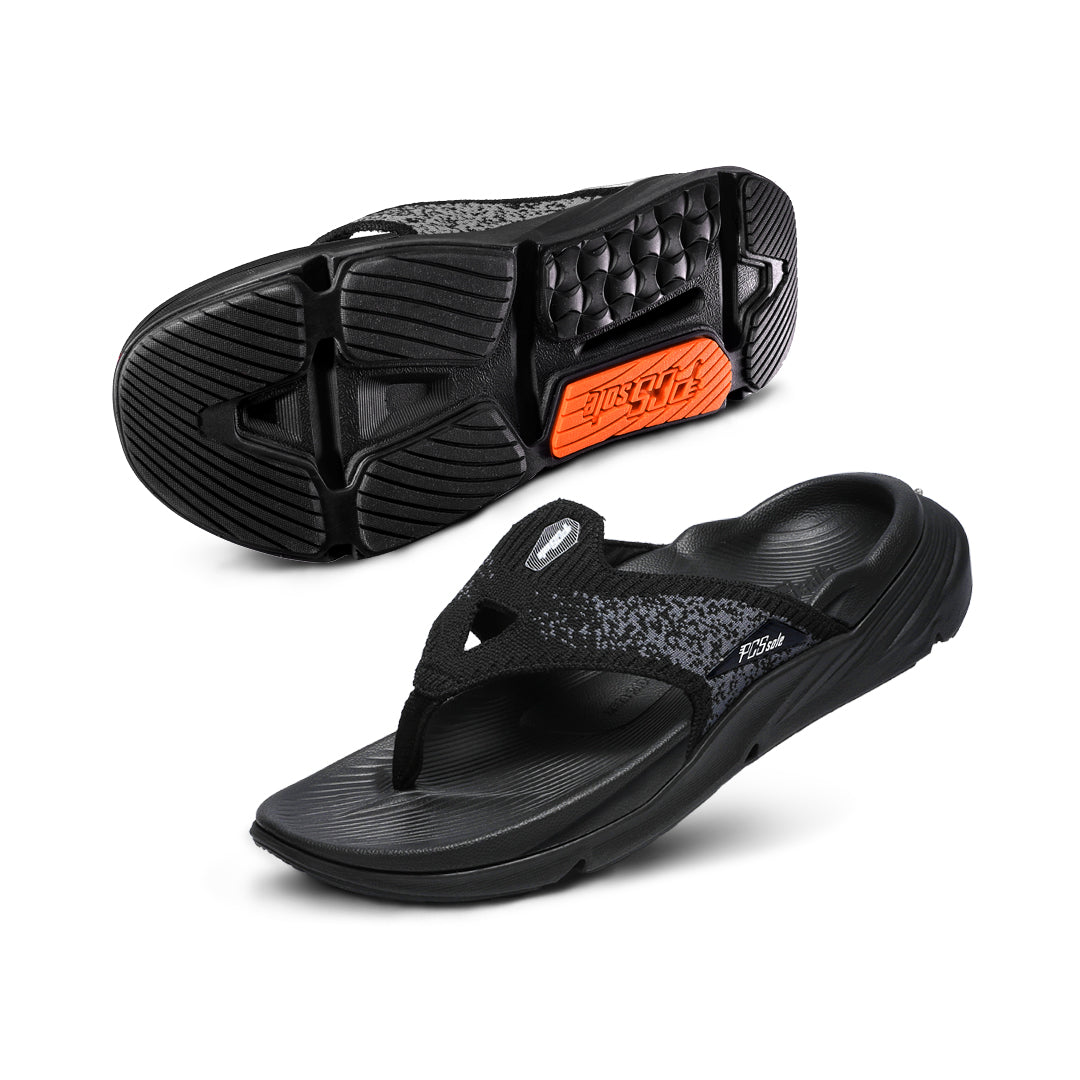
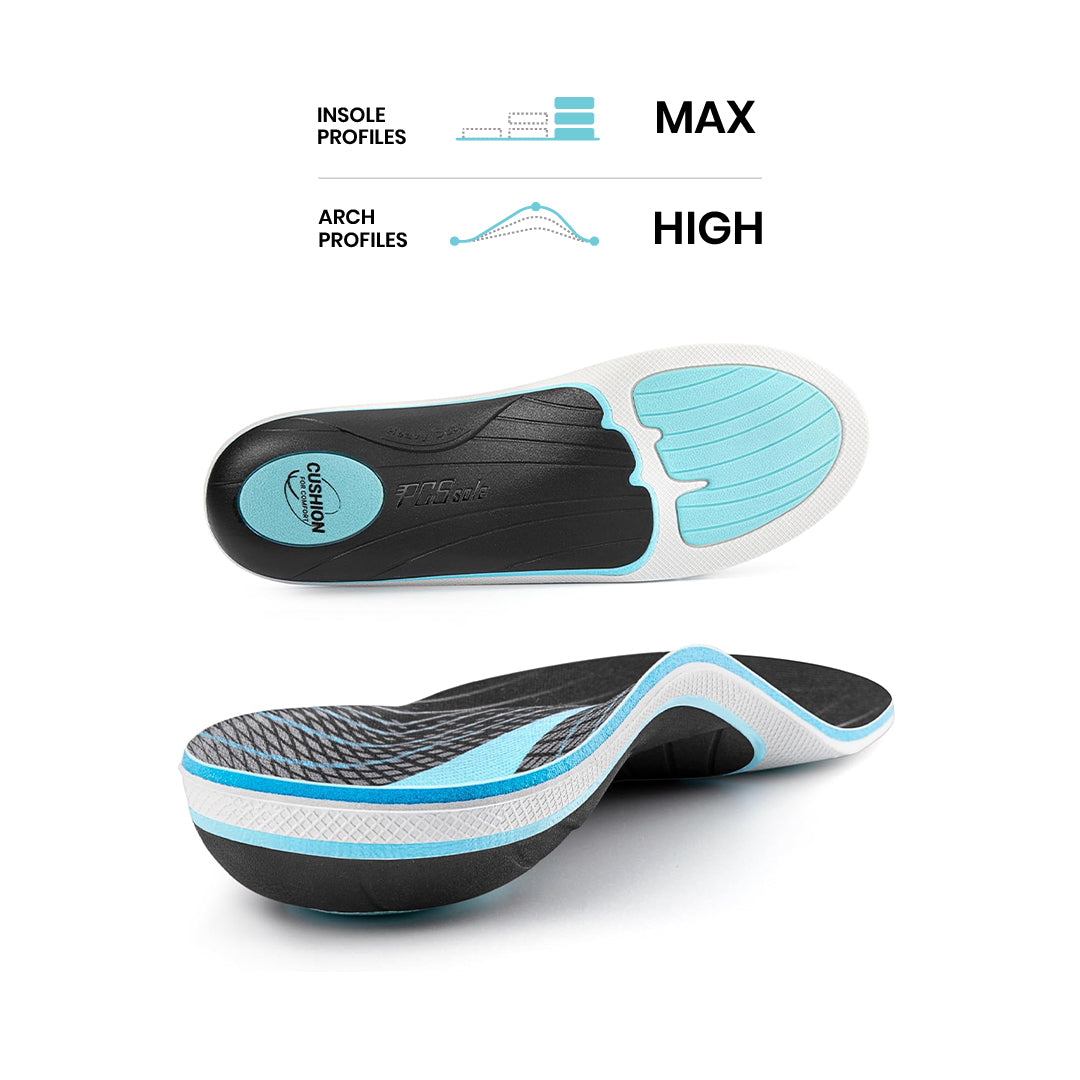
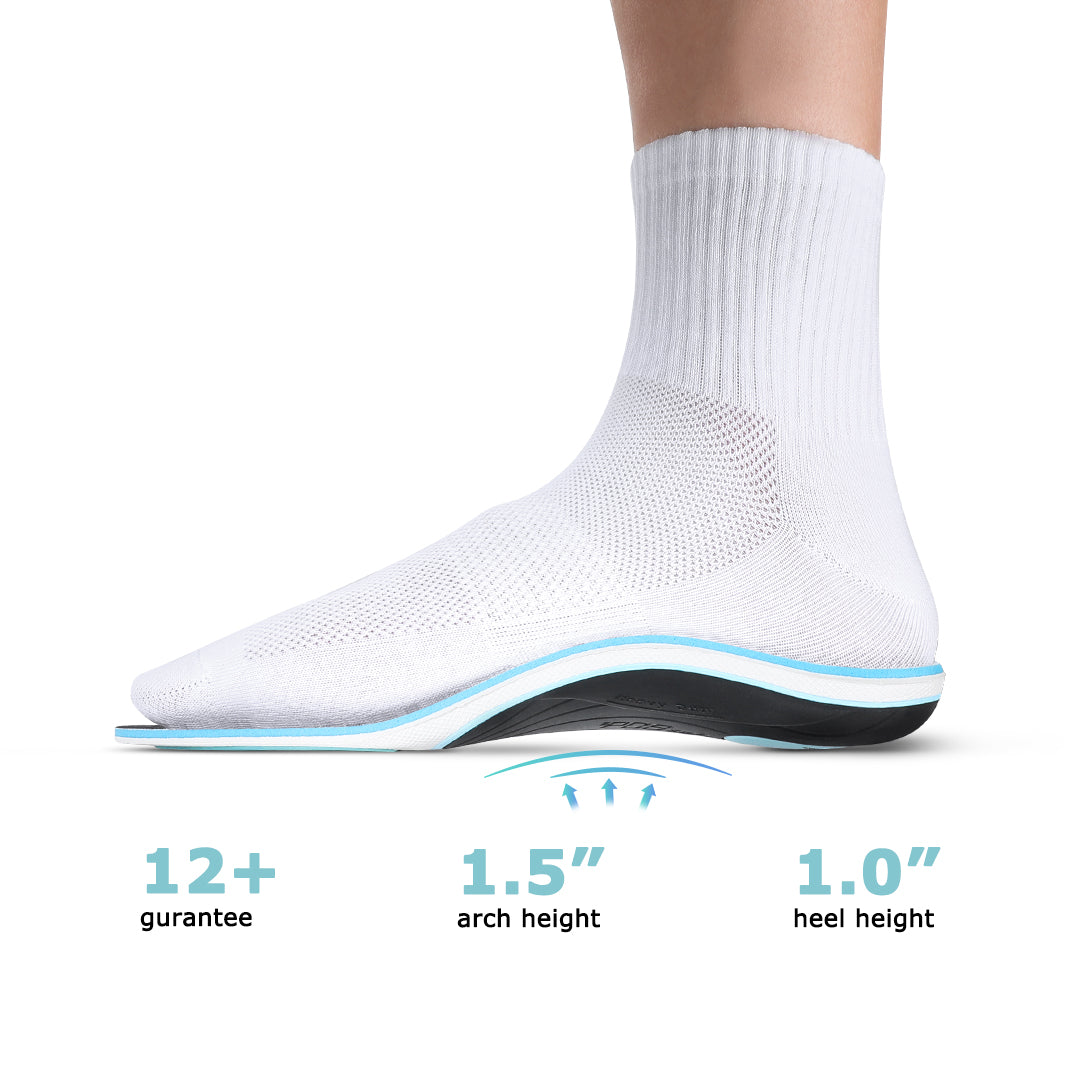
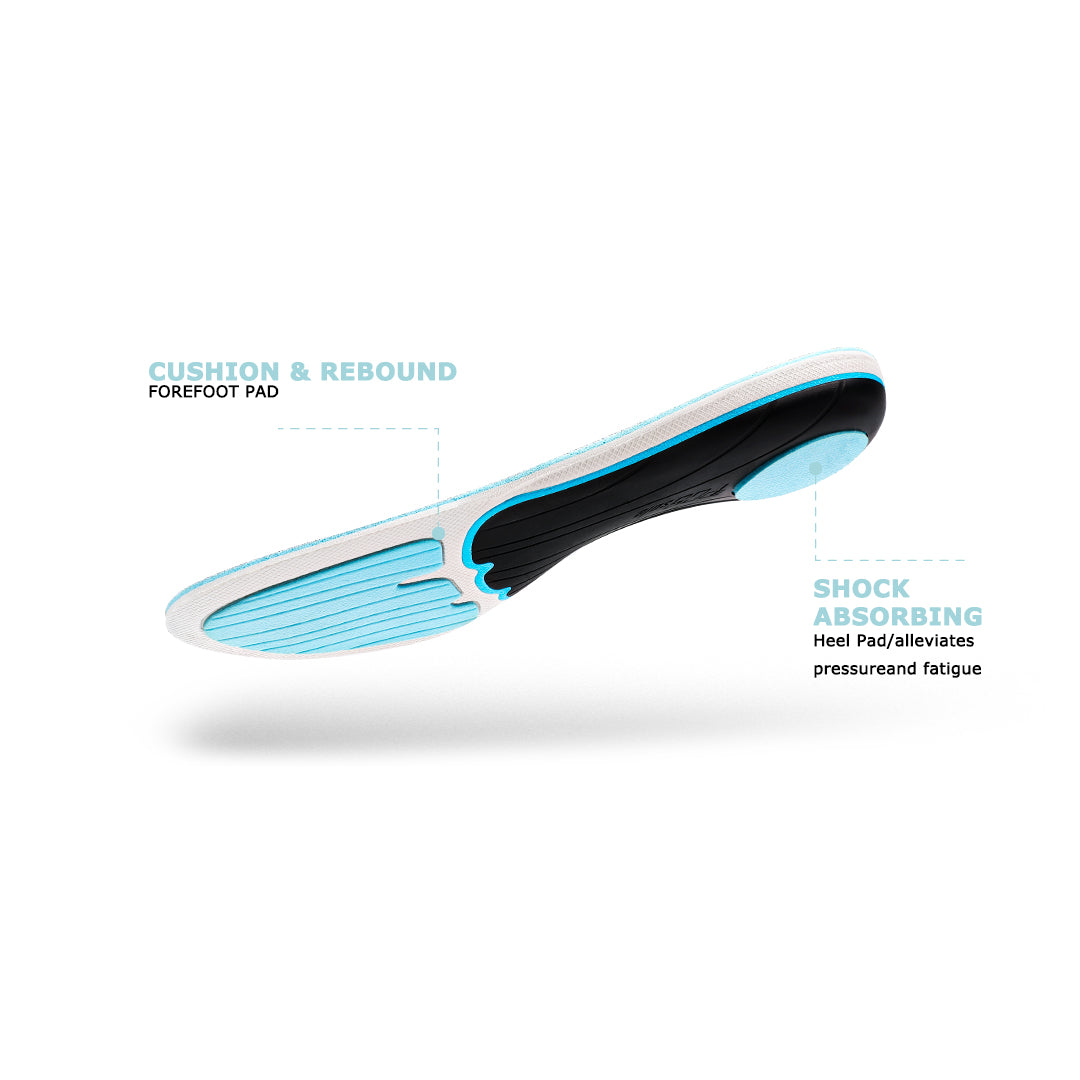
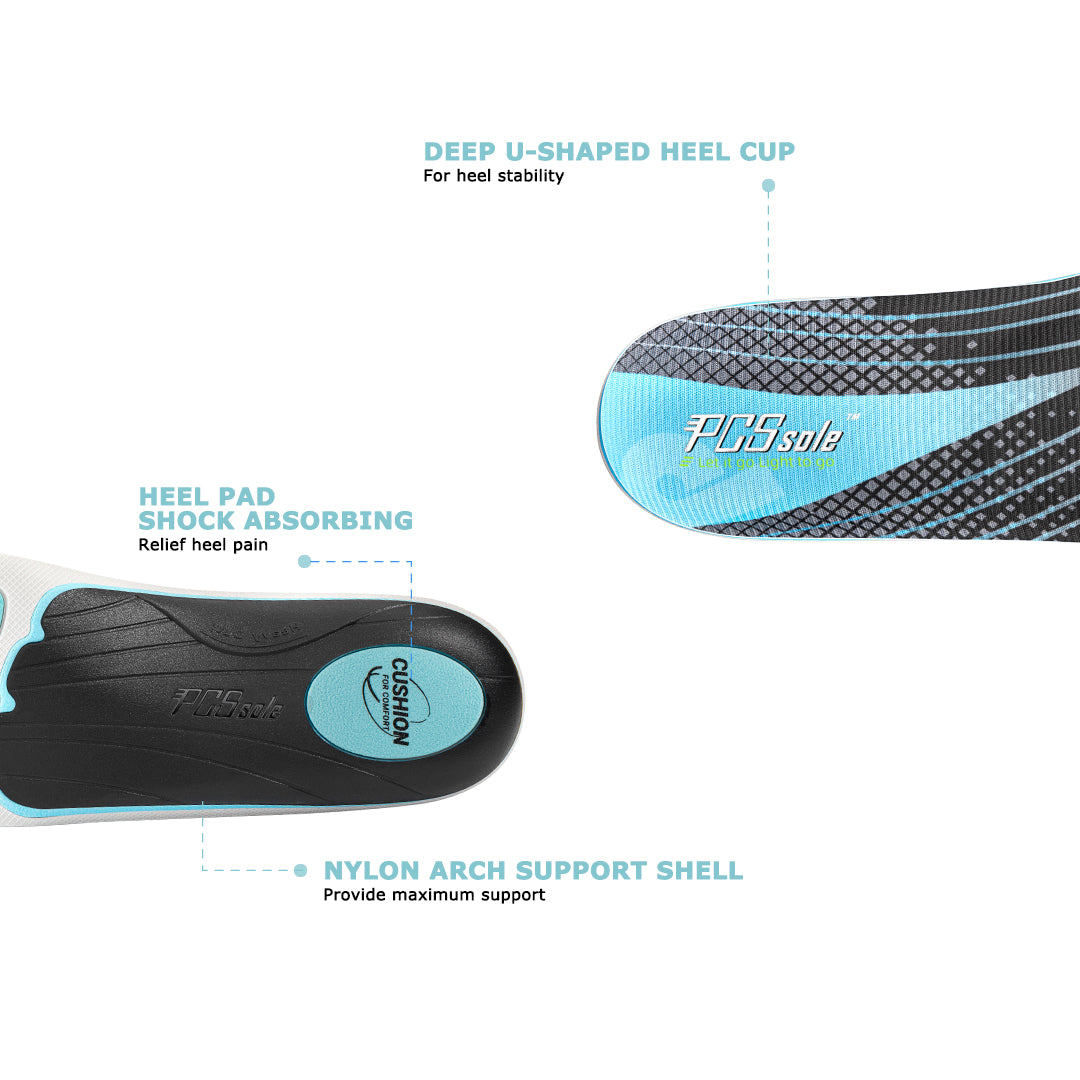
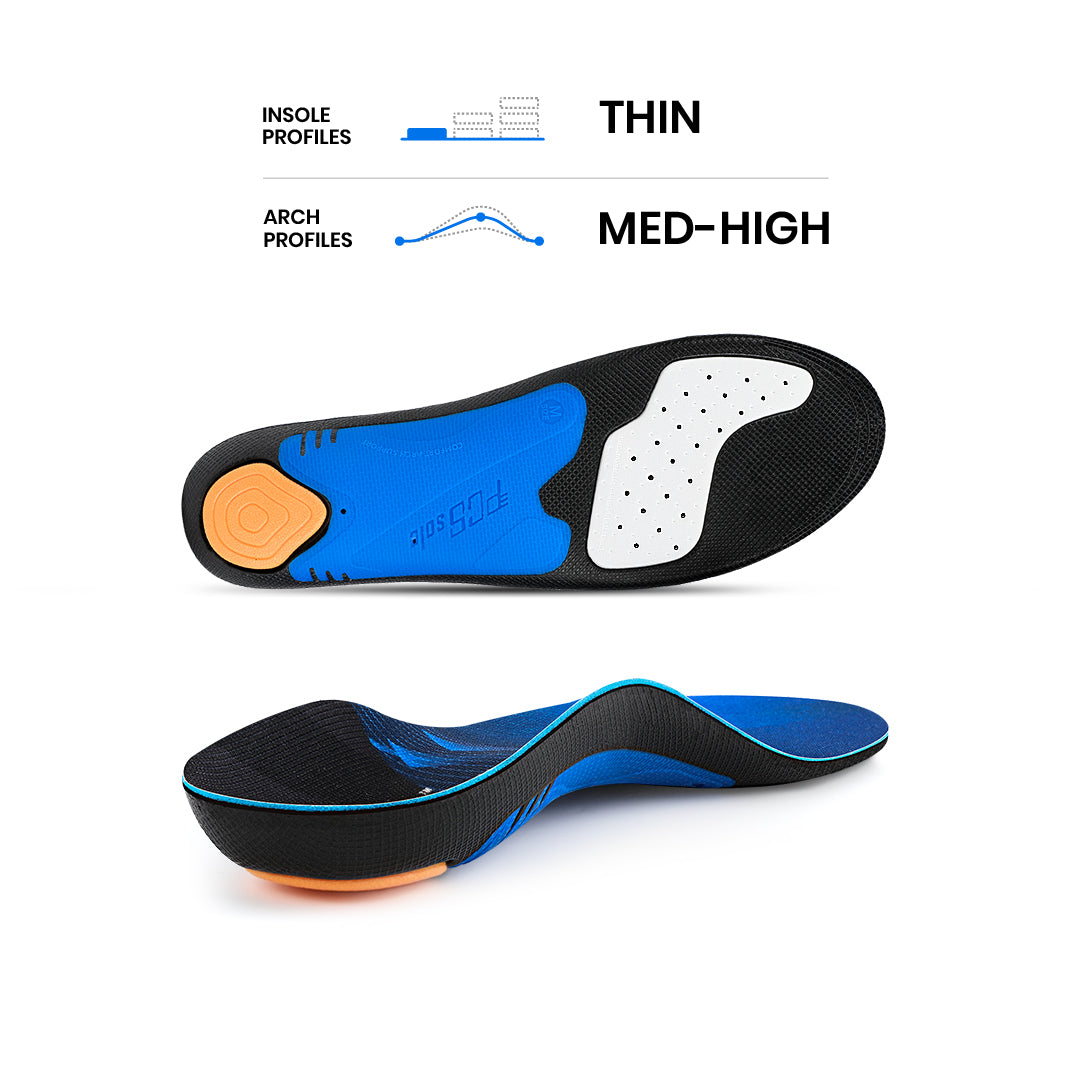
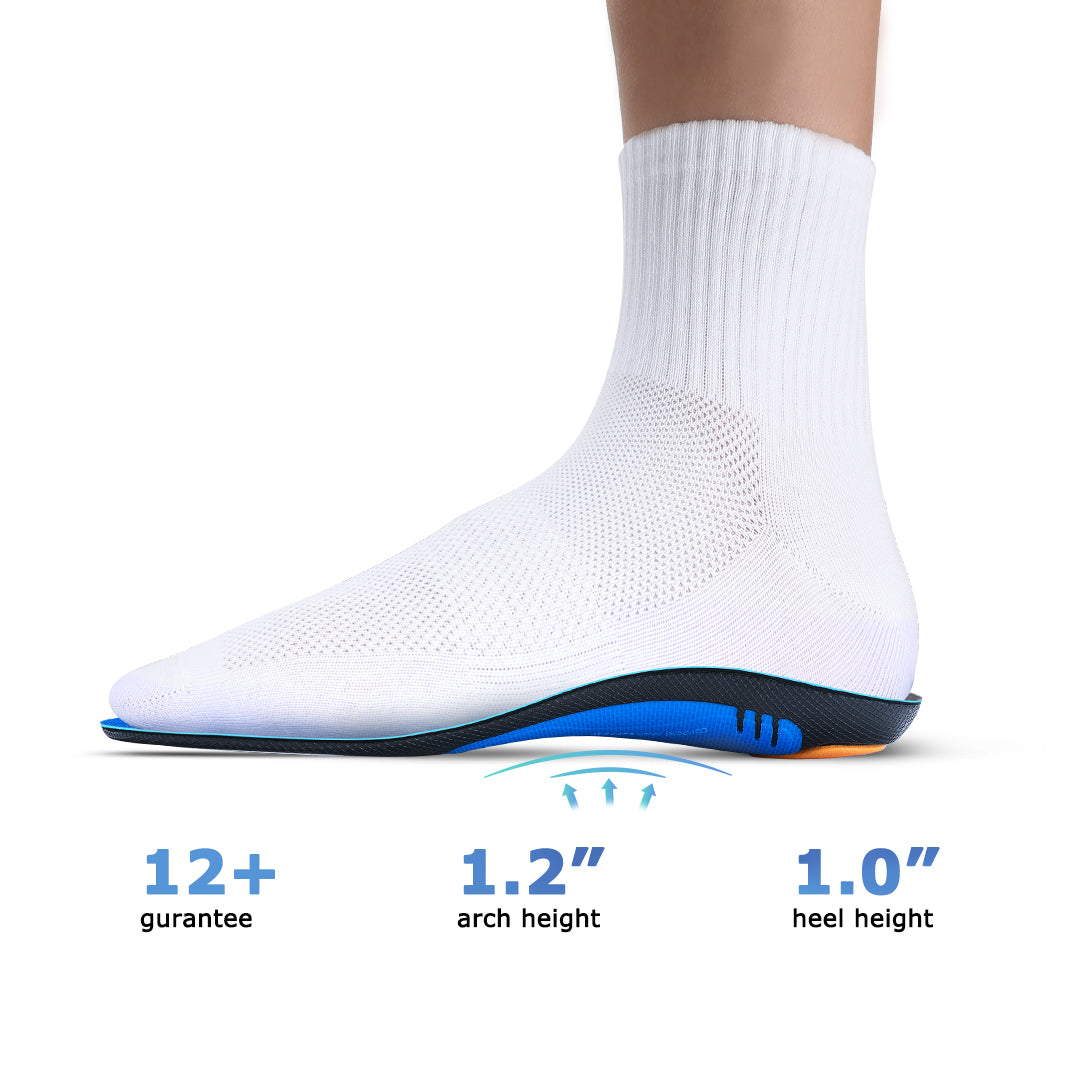
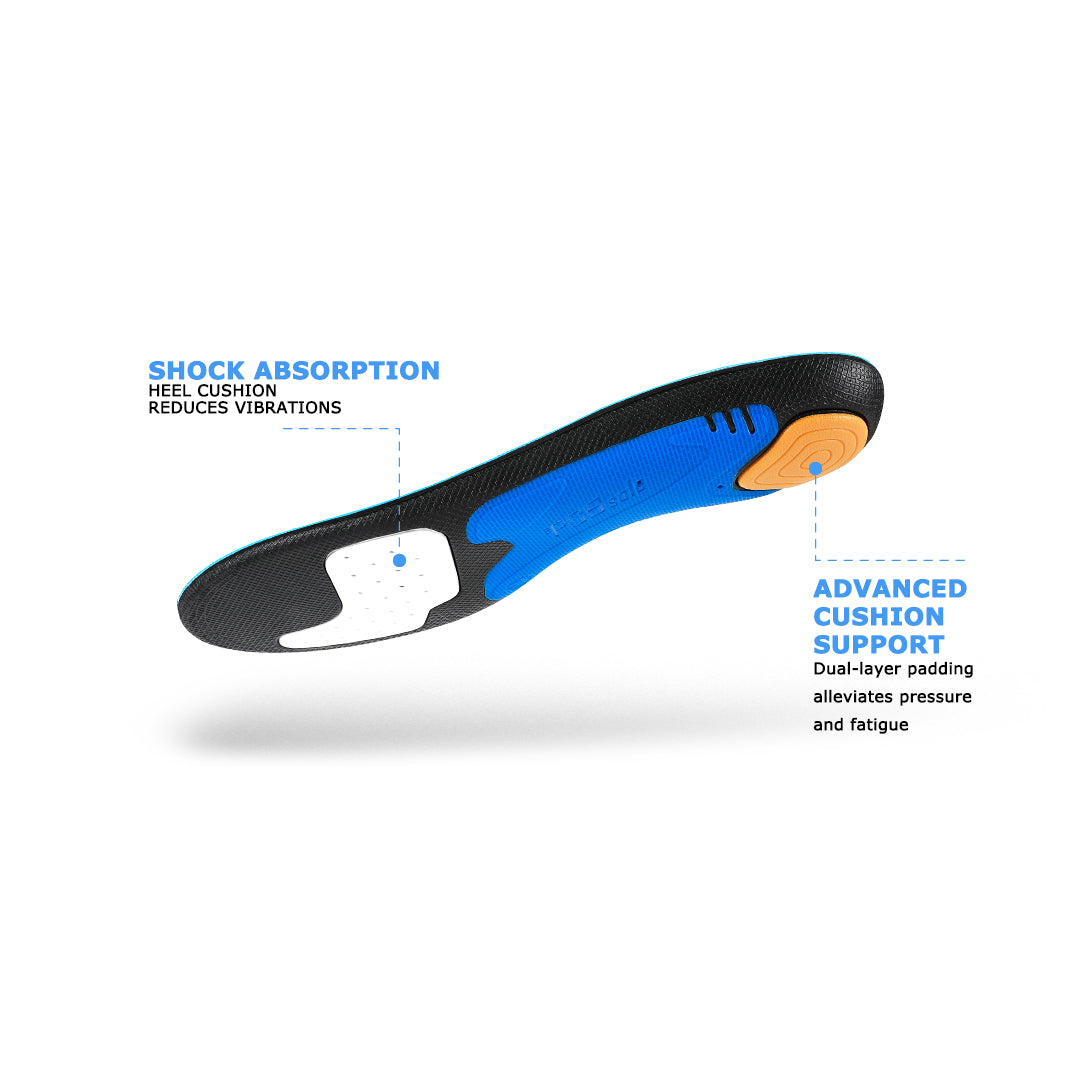
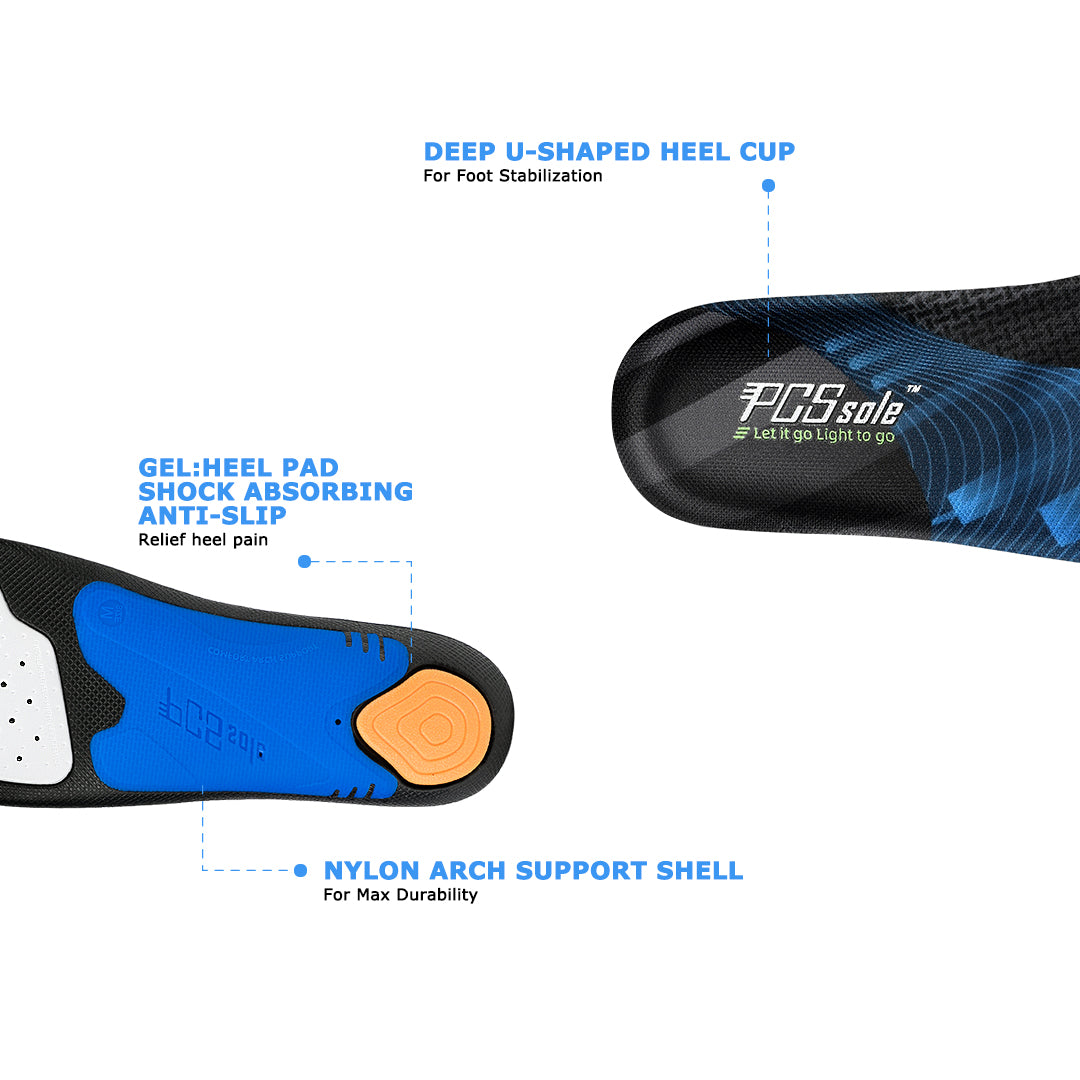
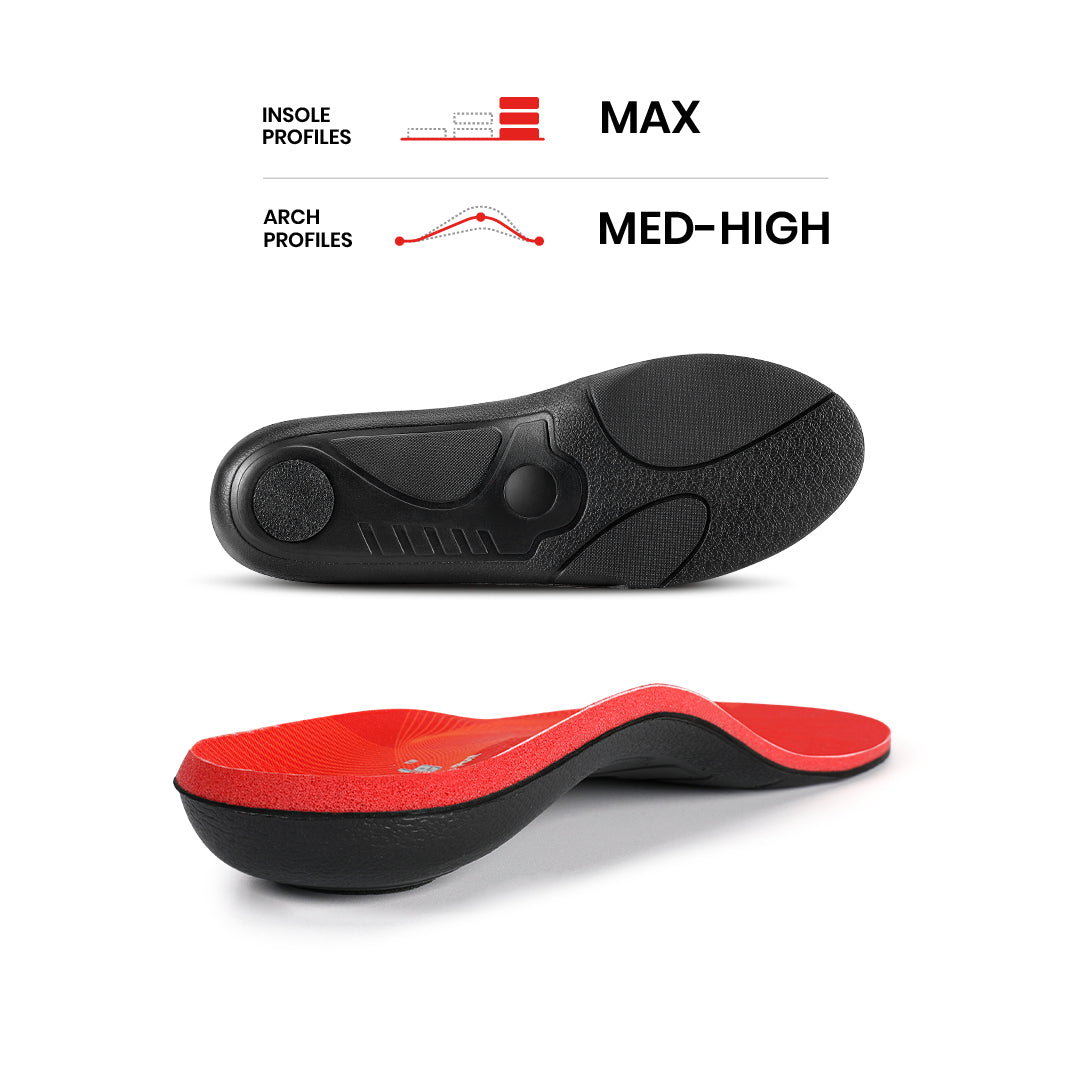
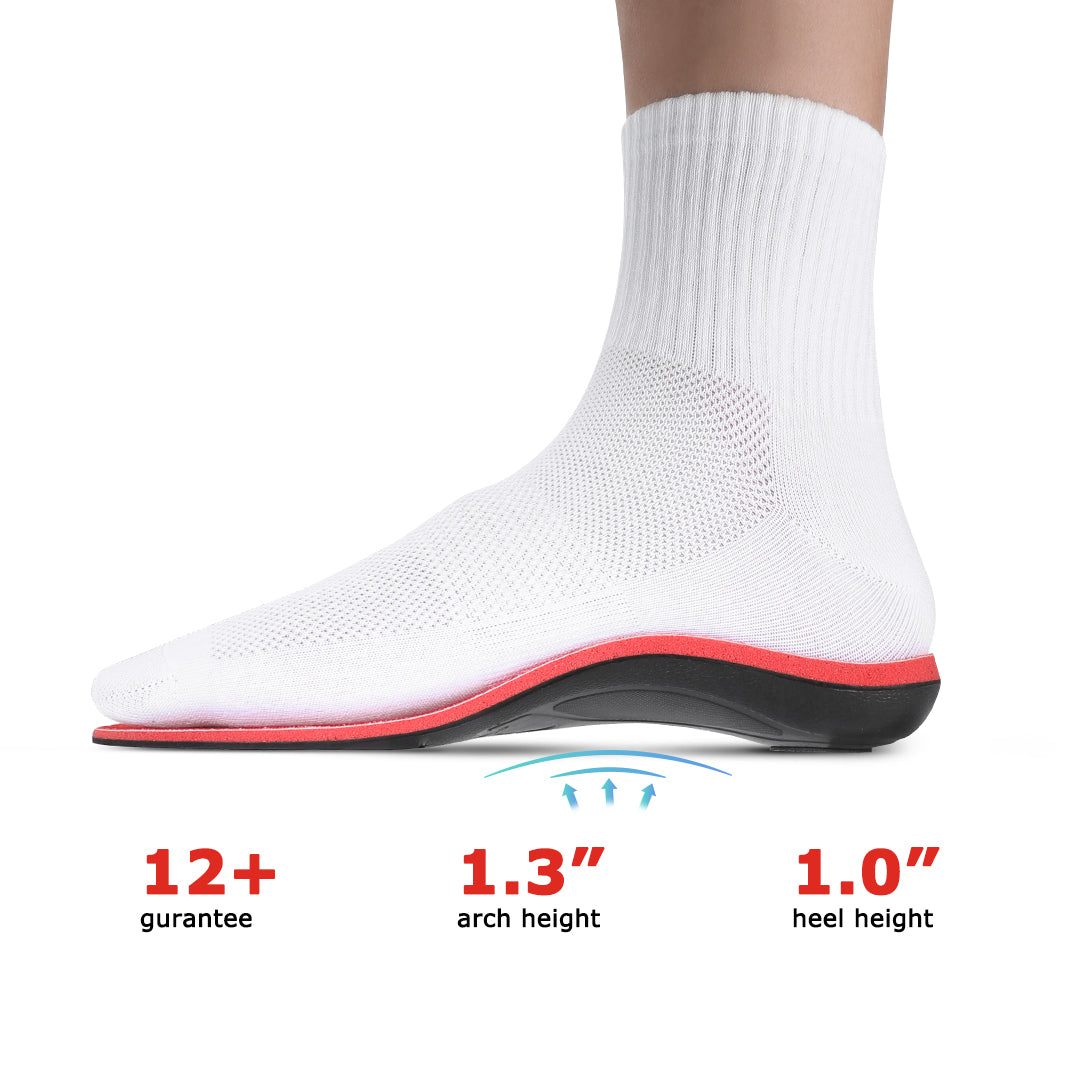
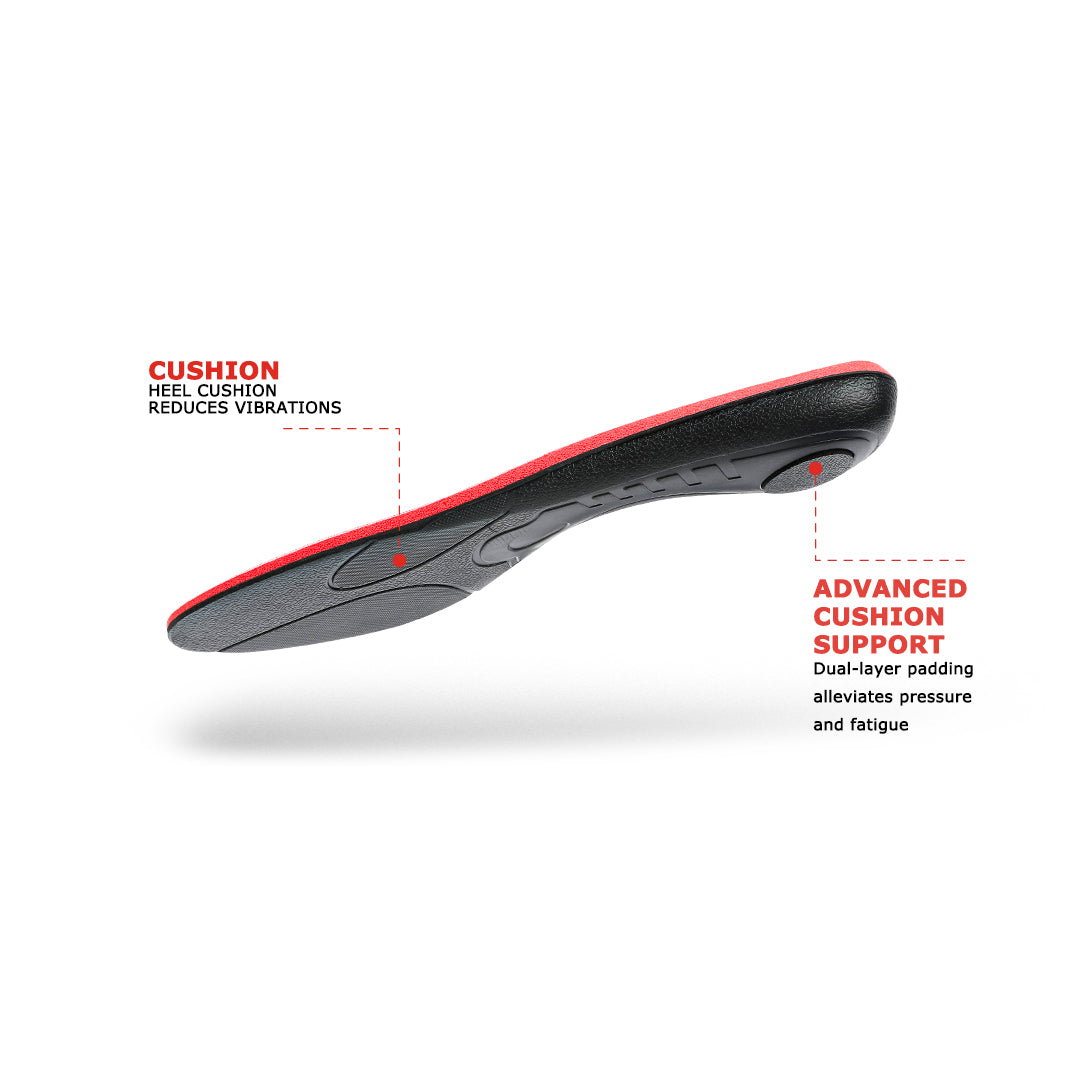
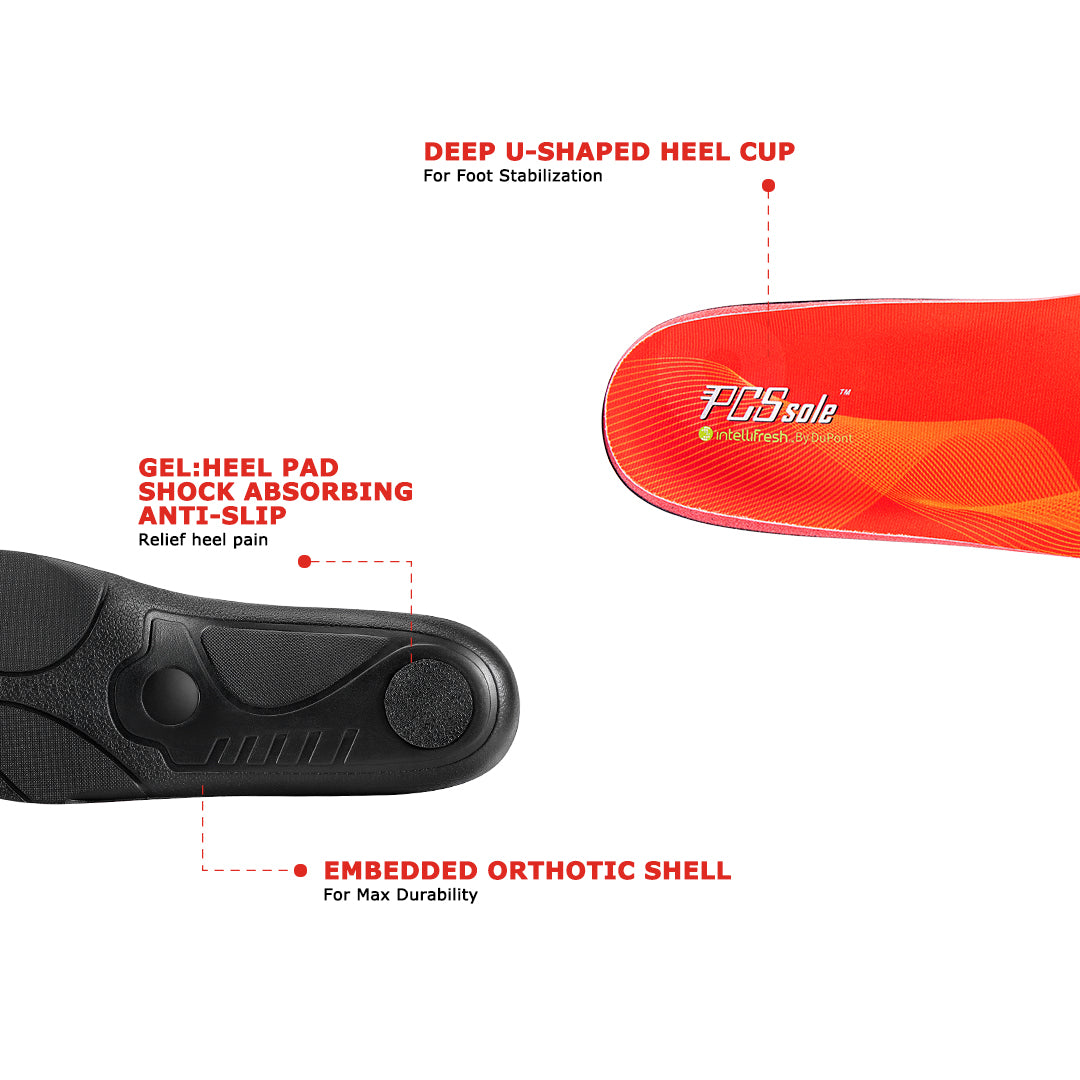
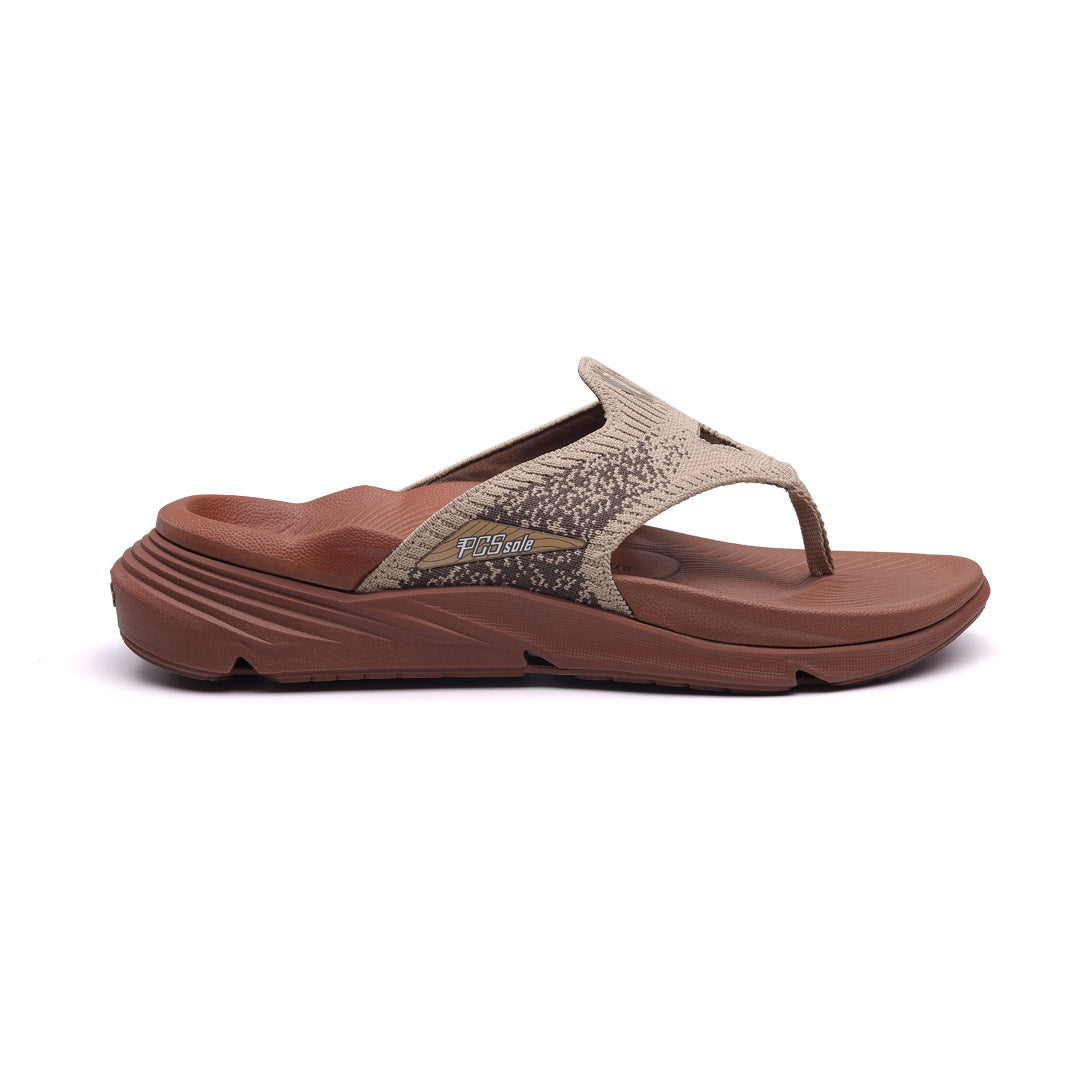
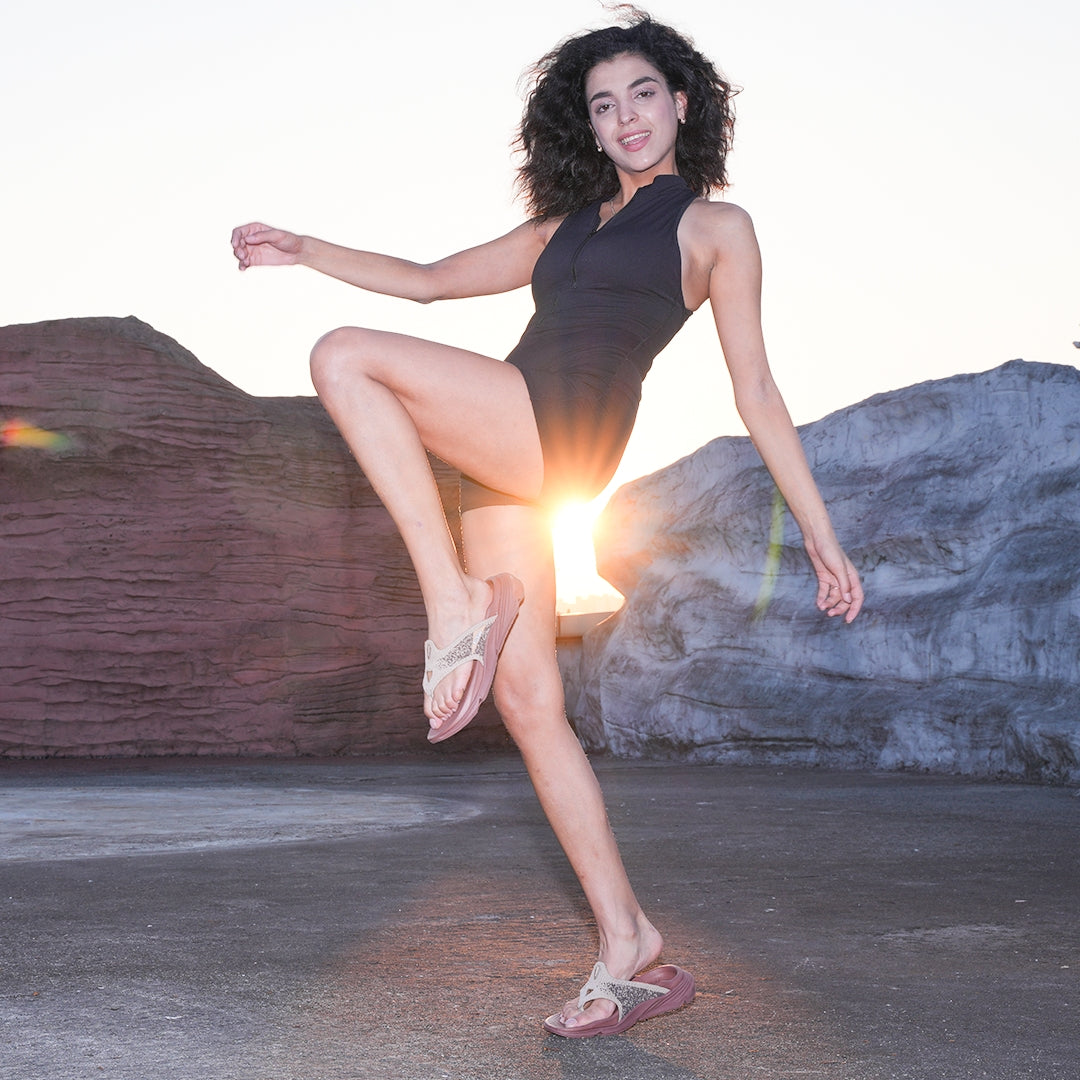

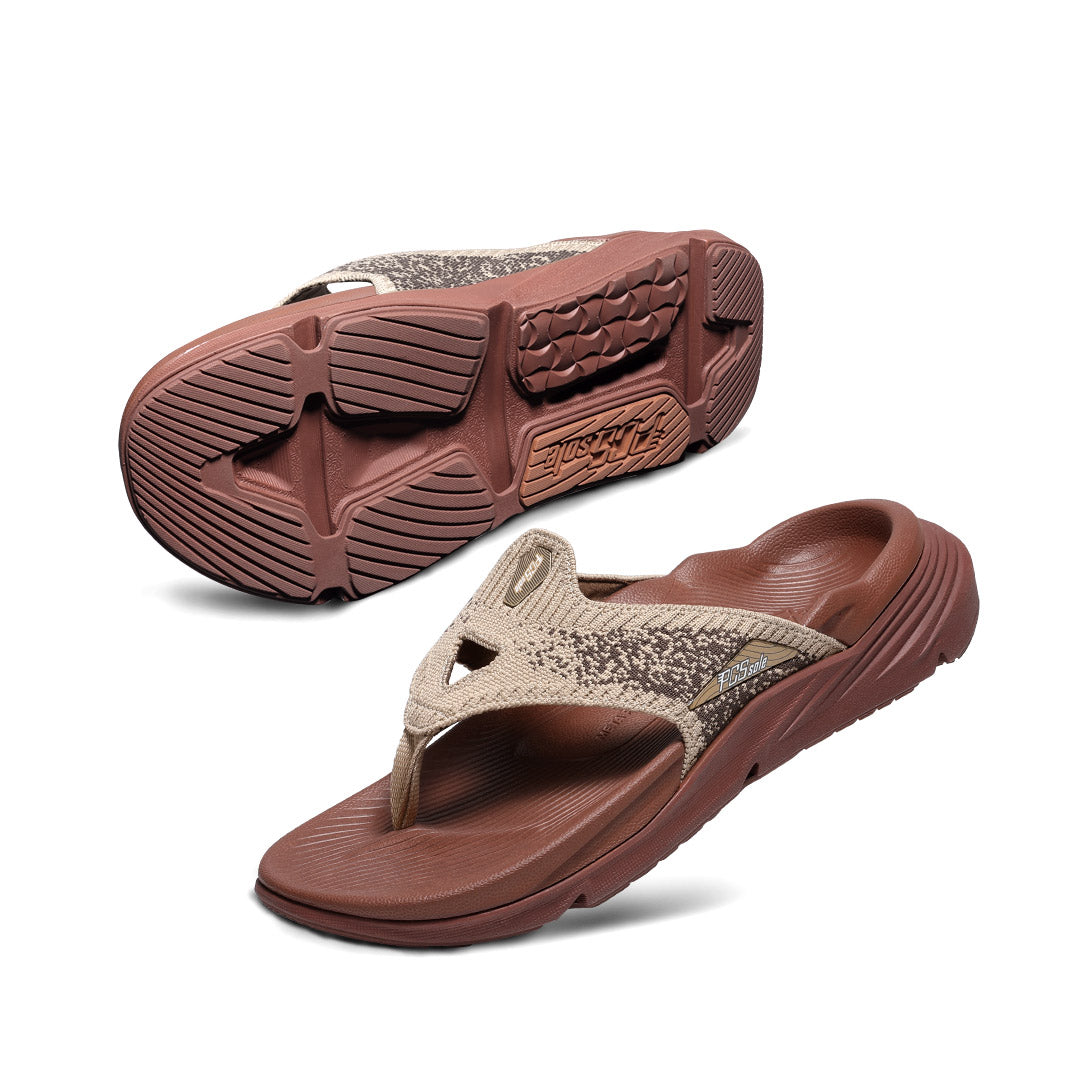
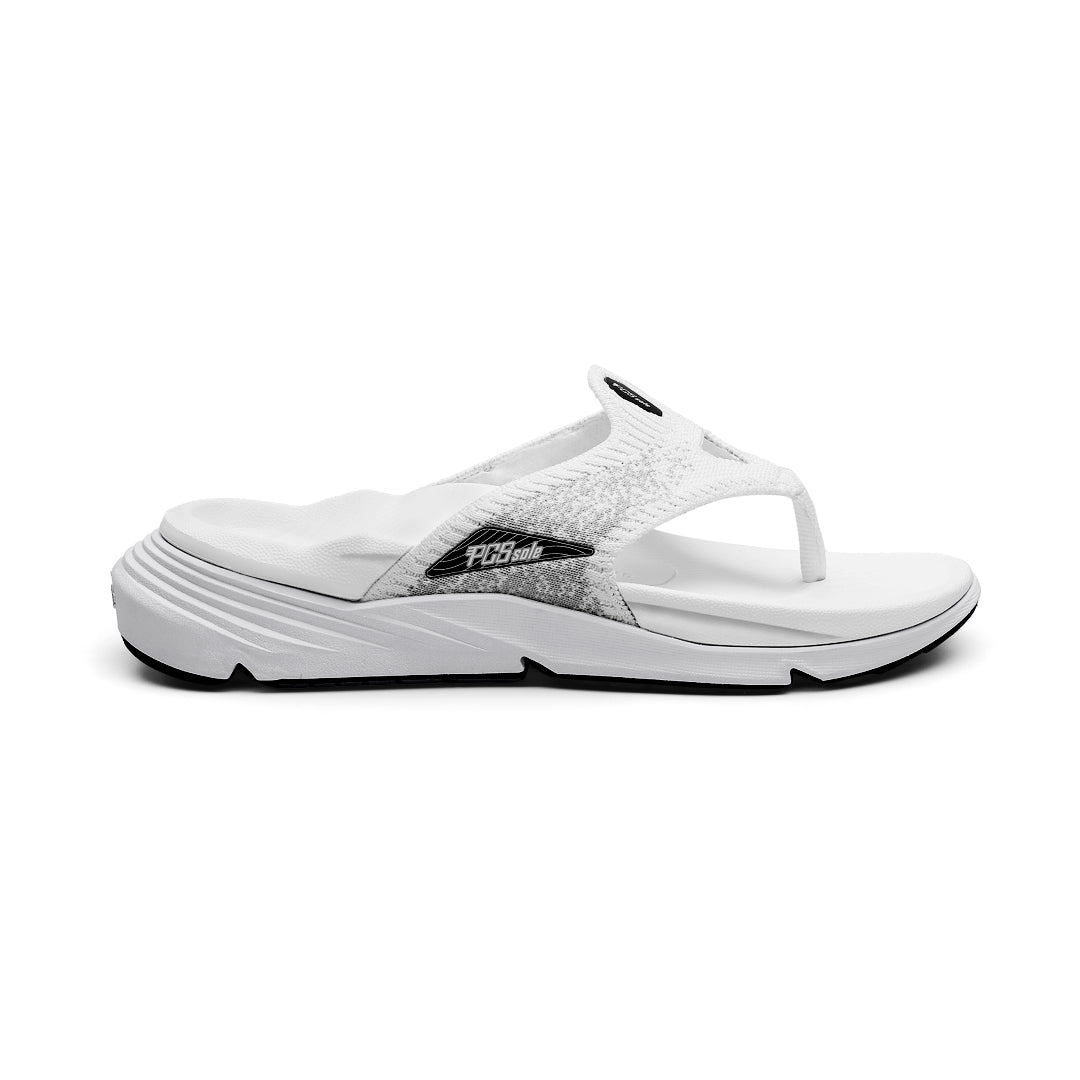
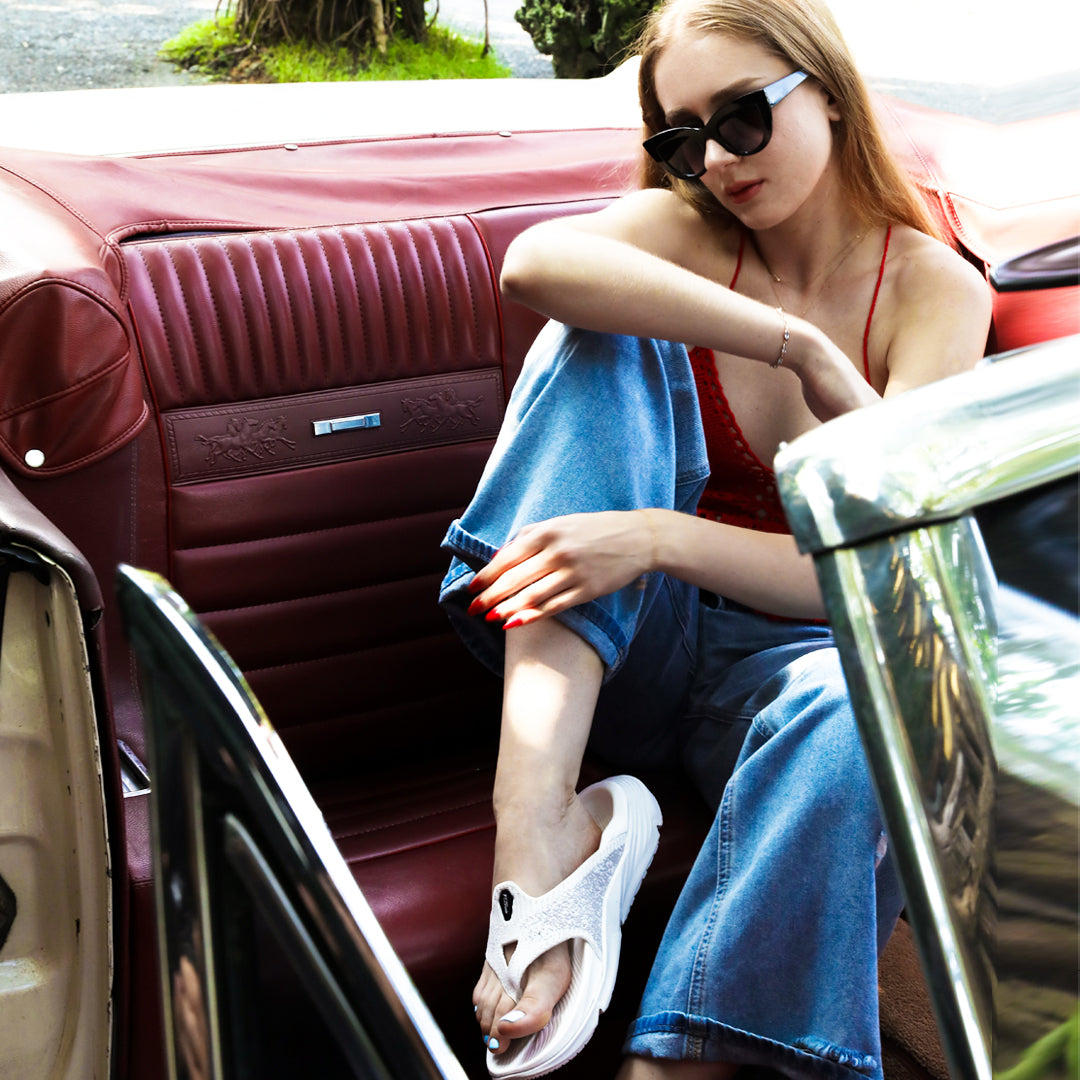
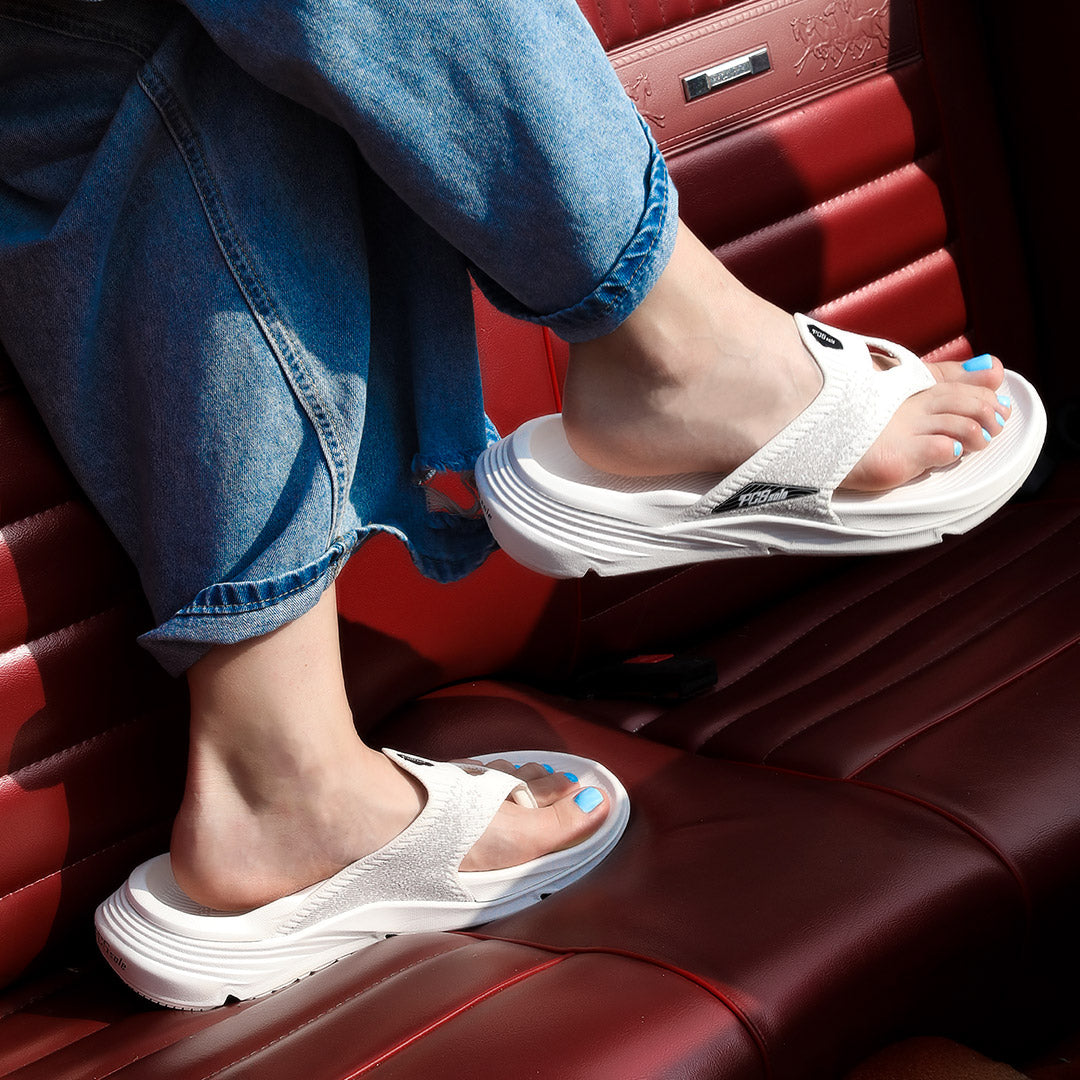
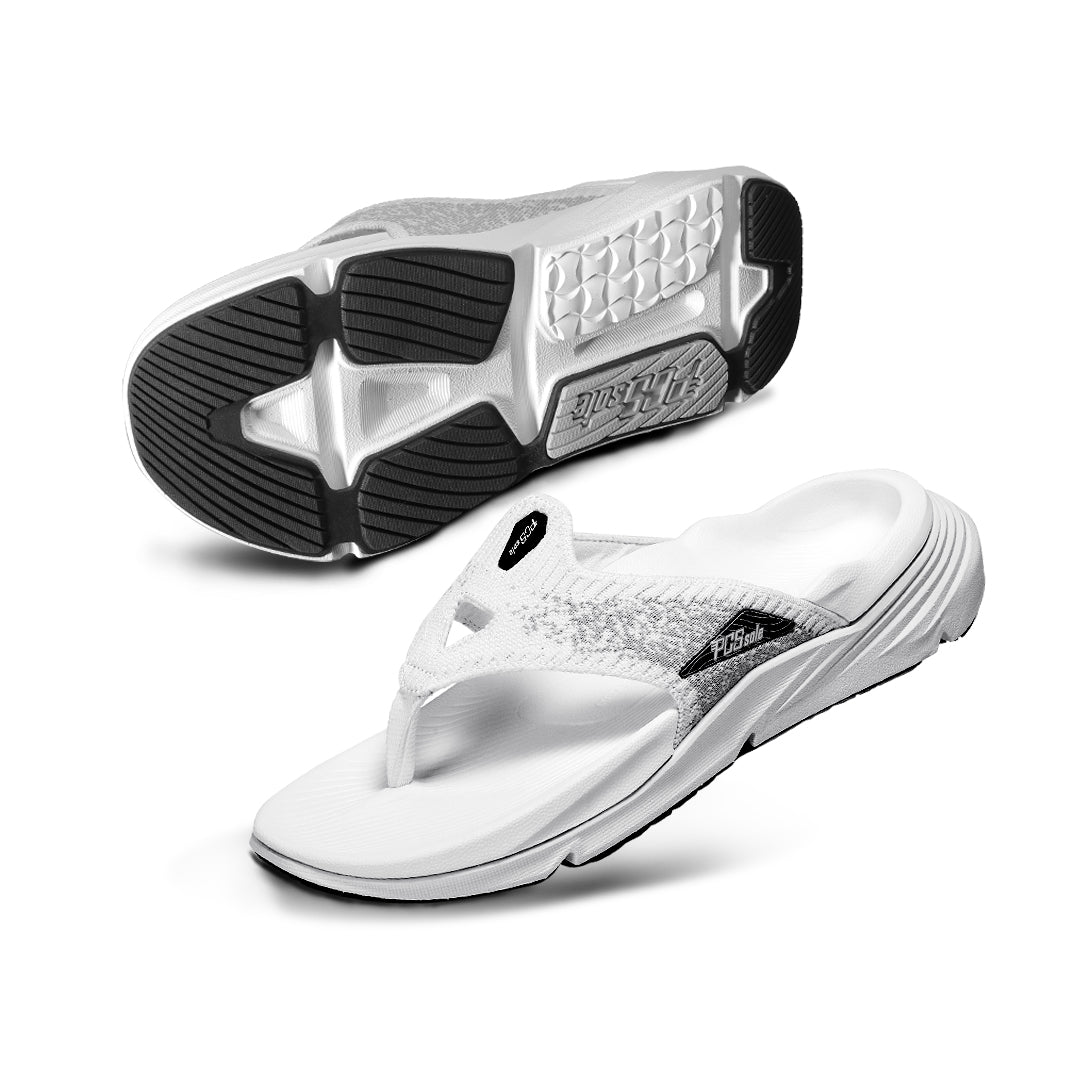
Aktie:
Are Foot Pain and Back Pain Related? A Podiatrist’s Perspective
Best Ball of Foot Pain Relief 2025: Metatarsalgia Treatment In ONE Step